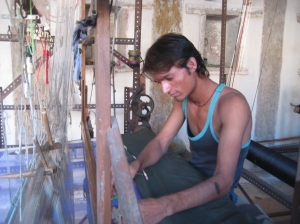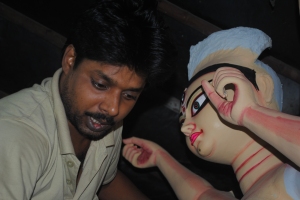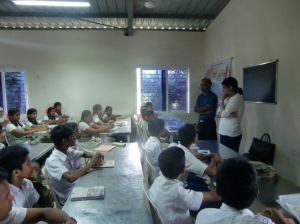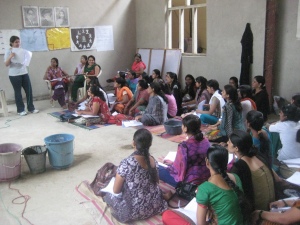Listening to stories has always been a delightful experience. It takes me back to the glorious childhood days of listening to grandmother tales. At the core of her every fascinating story would lay the epic world of Mahabharta, Ramayana or any other Puranas. Story telling is a popular tradition and one of the oldest art forms of India. Each community and region has its own style and manner of narrating the stories illustrating the richness of their culture. Today the traditional art of storytelling is vanishing from India and losing its place in our fast paced modern lives.
During our visit to the Dastakari Haat Samiti’s bazaar at Dilli Haat we reconnected with some forgotten tales, the fading art form and a few of these captivating artisans who keep this tradition alive.
Kawad – the portable temples.
Kawads are an ingenious piece of craft unfolding the stories of great Indian epics. This wooden portable shrine have multiple panels’ hinged together opening outwards illustrating a classic tale. The storyteller opens them in sequence of the events of his  narration. The recitation includes narration of stories tracing lines of descents, almost simulating an experience of travel to a pilgrimage. A traditional kawad would typically be painted in red with 10 doors reciting Krishna’s and Rama’s stories. Today the artists make smaller kawads with 8 or 6 doors as decoration pieces covering subjects like mythology, religion, festivals and also contemporary and social issues.
narration. The recitation includes narration of stories tracing lines of descents, almost simulating an experience of travel to a pilgrimage. A traditional kawad would typically be painted in red with 10 doors reciting Krishna’s and Rama’s stories. Today the artists make smaller kawads with 8 or 6 doors as decoration pieces covering subjects like mythology, religion, festivals and also contemporary and social issues.
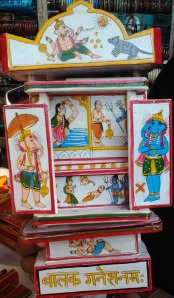 This Chittorgarh based kawad artist Dwarka Prasad Jhangid was excited to narrate Lord Ganesha’s story demonstrated on a beautiful white Kawad. On being asked about the history of this craft form, he proudly shared that the art form traces its roots from Bassi (near Chittorgarh, Rajasthan), and that it’s a 500-year-old tradition practiced by a group called “Jangid” Brahmins.
This Chittorgarh based kawad artist Dwarka Prasad Jhangid was excited to narrate Lord Ganesha’s story demonstrated on a beautiful white Kawad. On being asked about the history of this craft form, he proudly shared that the art form traces its roots from Bassi (near Chittorgarh, Rajasthan), and that it’s a 500-year-old tradition practiced by a group called “Jangid” Brahmins.
Patachitra – Pata chitra katha
A unique form of storytelling from Bengal and Orissa where a chitrakar pours his artistic imagination into scrolls made of dried palm leaf canvas and handloom cloth and narrates versions of episodes culled from Hindu mythology or their local heros. In earlier days, the patuas (chitrakars) would travel village to village, sit before a large audience and sing out their stories. The picture stories manifest rich bright colors, creative motifs and themes inspired by tales of Hindu legends and Indian mythological characters.
Apart from entertainment, these art forms are becoming a medium of education and information. The paintings depict strong social messages and address issues like evils of dowry, female feticide, fight against terrorism and women safety and demonstration of the recent brutal rape case in Delhi.
An accompanying song is a very important element of story telling. The chitra drawn by him is in rendition of his song. This was perfectly illustrated by Shahajan Chitrakar, who sang a melodious song in Bengali whilst reciting his story pointing at the deities in his painting frame by frame. 
It was heartening to learn that these artists use only vegetable dyes and stone colors to create their pieces of work. Radha Chitrakar, another Patachitra artist from the Medinipur, West Bengal talks about the exciting process of extracting and preparing these colors at home, white color from processing conch shell, yellow from turmeric, green from beans and betel leaves, red from hingula and black by soot leaves and from burning lamp dust.
It is incredible to realize that these artisans use no special equipment but only their Imagination to weave such wonderful and colorful stories. As the storytellers disappear, so does the country’s history, mythology and an important form of artistic expression!



















